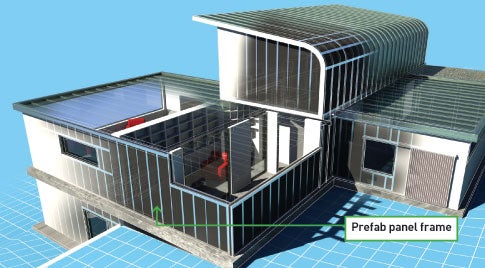One Man’s Mission to Build an Eco-Friendly, Affordable Home
Pre-fab panels instead of a wood frame save cash and energy

John B. Carnett, PopSci’s staff photographer, is using the latest green technology to build his dream home. Follow his progress in his monthly magazine column (the first of which you’re reading now) and on the Green Dream blog.
In the past 20 years, I’ve lived in some pretty weird places — a leaky loft, a sailboat, an old carriage house that I rehabbed myself. Makeshift bachelor pads were fine until I found myself with a wife and two small boys.
Stage #1: Build the Box
Now I’m building a real home on three acres of land with river views and plenty of room for the kids to explore. And I’m going as green as I can, as cheaply as I can, starting with the prefab panels that I’m using instead of lumber to build the basic frame.

Inside Sustainable Prefab Panels
These aren’t your conventional structural insulating panels. Instead of foam and strand board, Kama Energy Efficient Building Systems in Las Vegas custom-makes the rigid panels out of light-gauge metal studs and a special type of expanded polystyrene called Neopor that’s non-toxic, fully recyclable and blended with graphite to lock out heat, moisture and mold. My home is the first in the U.S. to incorporate Kama’s new panels. They cost me about 5 percent less than a stick frame would have, but they’re 60 percent more energy-efficient and can cut heating and cooling bills in
half.

The Secret to Energy Savings
The walls arrive on site pre-cut and ready to install, no special tools or hired help required. With a few buddies, I simply tilted the panels in place and secured them to a steel track on the foundation, building the whole box in less than eight days. A lumber frame would have taken me weeks to measure, cut, fit, and nail everything in place. Other types of insulating panels can require extra labor and a crane to install — in other words, more time and money.
Now that I have the frame and my insulation taken care of in one step, I’m looking at a passive solar hot-water system. That’s next month’s project.
The Specs
House: 3,500-square-foot, four-bedroom contemporary
Location: Greenwich, N.Y.
Project: Install a prefab panel box
Cost: $7.04 per square foot
Time to install: Approx. 8 days
Materials: Metal frame filled with expanded polystyrene and graphite
Eco advantages: Fully recyclable; no off-gassing, heat loss or mold